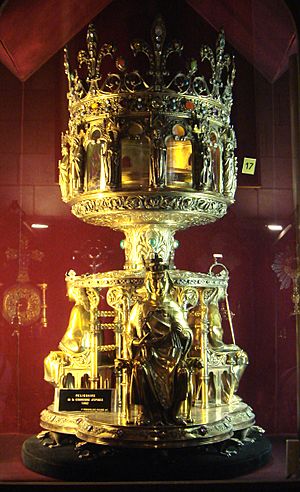Baldwin II, Latin Emperor facts for kids
Quick facts for kids Baldwin II |
|
|---|---|

Seal of Baldwin II
|
|
| Latin Emperor of Constantinople | |
| Reign | 1228-1273 (in exile 1261-1273) |
| Coronation | 15 April 1240 |
| Predecessor | Robert of Courtenay |
| Successor | Philip I |
| Regent and co-emperor | John of Brienne (1229–1237) |
| Born | c. 1217 Constantinople (modern-day Istanbul, Turkey) |
| Died | October 1273 (aged 55–56) Naples (modern-day Italy) |
| Spouse |
Marie of Brienne
(m. 1234) |
| Issue | Philip of Courtenay |
| House | Courtenay |
| Father | Peter II of Courtenay |
| Mother | Yolanda of Flanders |
| Religion | Roman Catholicism |
Baldwin II, also known as Baldwin of Courtenay, was the very last Latin Emperor to rule from Constantinople. He was born in late 1217 and passed away in October 1273. His time as emperor was full of challenges.
Contents
Biography
Early Life and Becoming Emperor
Baldwin II was born in Constantinople, a major city. He was the only Latin Emperor to be born there. His mother was Yolanda of Flanders. She was the sister of the first two emperors, Baldwin I and Henry of Flanders.
Baldwin's father, Peter II of Courtenay, was the third emperor. After his father, Baldwin's older brother Robert of Courtenay ruled. When Robert died in 1228, Baldwin became emperor. He was only 11 years old at the time.
Ruling with a Regent
Because Baldwin was so young, important leaders chose John of Brienne to rule as a "regent." A regent is someone who governs a country when the king or queen is too young or unable to rule. John was meant to be regent for life.
Baldwin was also set to marry John's daughter, Marie of Brienne. This marriage happened in 1234. After John's death, Baldwin was supposed to take full control.
The Latin Empire had been getting weaker for a while. The Byzantine power was growing stronger. Many hoped John of Brienne could fix things, but it was very difficult.
Struggles and Journeys
The empire Baldwin ruled was mostly just the city of Constantinople itself. He was in a very tough financial situation. He spent much of his life traveling around Europe. He would visit different courts, asking for money and soldiers. He hoped to get back the lands his empire had lost.
In 1236, he went to Rome, France, and Flanders. He even became the next Count of Namur with help from the King of France. But Baldwin was rarely there. Later, he sold his rights to Namur to his cousin.

Around 1238, Baldwin's advisors had to pawn, or give as a guarantee for a loan, a very important religious item called the Crown of Thorns. They gave it to merchants from Venice to get money.
Baldwin's efforts to raise money sometimes worked. In 1240, he returned to Constantinople with a large army. But he couldn't achieve much with this help. In 1245, he traveled west again, spending two years in Italy and France. His wife, Empress Marie, ruled while he was away. He was able to get more money from King Louis IX in exchange for other religious items.
Baldwin's money problems became so bad that he had to give his only son, Philip of Courtenay, to Venetian merchants. This was like a promise for loans. Philip was later freed by Alfonso X of Castile. Baldwin spent the rest of his rule traveling and asking for money.
Losing Constantinople
On the night of July 24, 1261, a group of soldiers led by Alexios Strategopoulos found a secret way into Constantinople. They captured the city. Baldwin was sleeping in his palace when the fighting woke him up. He fled so quickly that he left his crown and royal staff behind.
Baldwin escaped on a Venetian ship. He traveled to Athens, then to Apulia, and finally to France. Even though he no longer ruled Constantinople, he still held the title of emperor. His main job was still to ask Western leaders for help.
In 1267, he went to Italy. He hoped Charles of Anjou would help him take back Constantinople. Charles did consider it, but his plans were ruined by an event called the Sicilian Vespers. This event might have been secretly planned by Michael VIII Palaeologus of Constantinople.
Baldwin and his son Philip lived on money given to them by Charles. In October 1273, Philip married Charles's daughter. A few days later, Baldwin died in Naples. By the end of Baldwin's rule, Constantinople's population had shrunk a lot.
See also
 In Spanish: Balduino II de Constantinopla para niños
In Spanish: Balduino II de Constantinopla para niños

